Saturday, July 17, 2004
"a large-scale, interdisciplinary excavation"
Via rogueclassicism, www.archaeology.org's "Interactive Dig Sagalassos."
It's not high-grade, but I have a coin from Sagalassos.
It's not high-grade, but I have a coin from Sagalassos.
Silvered Æ antoninianus, Gallienus, Antioch, Göbl 1612l
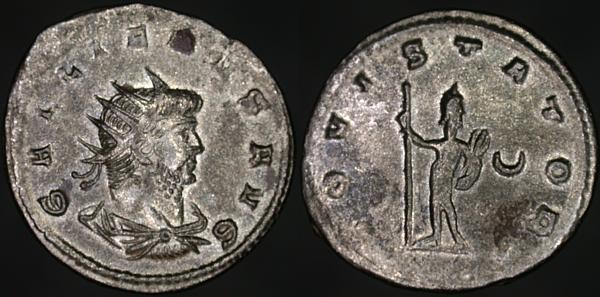
GALLIENVS AVG, Radiate cuirassed bust right | IOVI STATORI, Jove standing facing, head right, holding scepter left and thunderbolt right. Crescent in right field.
The reverse shows Jove in his aspect of Stayer (of armies about to flee). By me, it seems odd to advertise that Rome would need such services, but it seems to be part of Roman origin legends, and I suppose it was good to have that going for you when you needed it.
The loopy G's, that look like 6's, at the beginning and end of the obverse legend are interesting: I've seen this guy's work before, from this mint, as here and here.
Roman coinage spans enough centuries that making broad statements is risky, but I think that there were a relatively small number of people doing the skilled work like die-engraving at any given mint and time.
Friday, July 16, 2004
Æ27, Serdica in Thrace, Gallienus, unknown
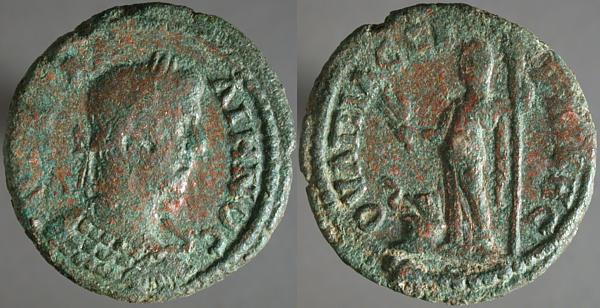
ΑVΤ Κ ΓΑΛ_ΛΙΗΝΟC,Laureate cuirassed bust right, seen from slightly behind | ΟVΛΠΙΑC CΕ_ΡΔΙΚΗC, Demeter standing left, holding torch right and grain stalks left. Snake emerging from basket at feet left.
Yesterday I posted a coin minted in Rome, showing Annona, personification of the corn dole. While there's no Greek equivalent, Demeter was the model for both Ceres and for Annona in her original form as a harvest goddess.
The appearance of a cista mystica, the snake basket, as an attribute of Demeter, is a bit unusual, but snakes were sacred to Demeter: grain-fields ready for harvest attract many rodents, and they attract snakes. The ancients were aware that snakes were helping them by eating those rodents.
This was minted at Serdica, today Sofia, capital of Bulgaria.
Thursday, July 15, 2004
Silvered Æ antoninianus, Gallienus, Rome, Göbl 495f
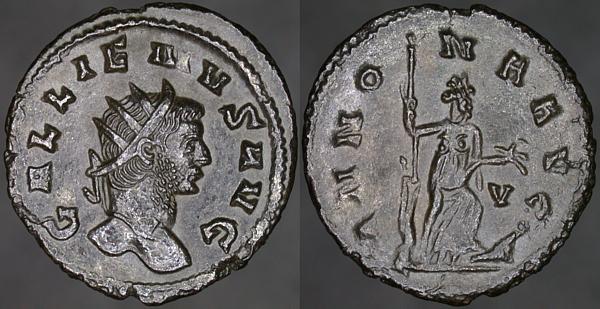
GALLIENVS AVG, Radiate head right | ANNONA AVG, Annona standing facing on prow right, head right, holding oar? left and ears of grain right. V in right field.
Back in February, when I posted a Annona coin that's in the literature, but poorly documented, I didn't have a nice-looking example of the better-known version. That's remedied now.
Annona had been a Roman goddess of the harvest, but by this time she'd long been the personification of the corn dole, the government distribution of grain to the plebians. She's commonly seen, as here, with nautical symbols of oar and prow because Rome was dependant on importing grain from the provinces, particularly Roman Egypt.
Wednesday, July 14, 2004
Æ semiuncia, Roman Republic, 217-215 BCE, anonymous, Crawford 38/7
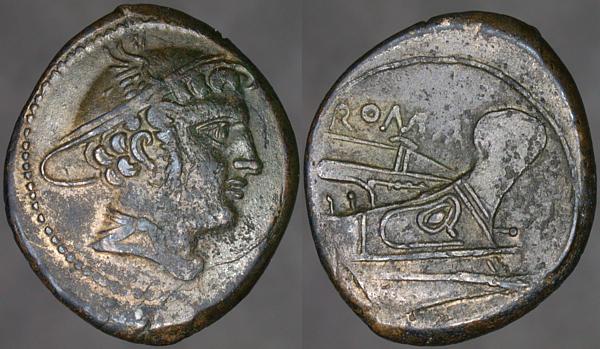
Head of Mercury right, in winged petasus | Prow right, ROMA above
Upgrading, buying a better example of an item already owned, is the bane of the collector's existence. Either the lower grade item shouldn't have been purchased, or the collector is chasing perfection, which will lead to quite a lot of "duplicates."
I try to only upgrade if I'm convinced I'm buying something that I'll never need to upgrade again. While this coin isn't perfect, I don't think I'll feel the need to spend what a better one would cost.
Mercury's sideburns and the eye on that prow both knock me out.
(This was what I replaced, so I feel pretty justified.)
The coin, struck under the authority of an anonymous moneyor, is dated to the period 217 - 215 BCE. In 216, Hannibal defeated the Romans at Cannae. While it's not very likely that this coin was there, it's entirely reasonable to think that someone was carrying this when they heard the terrible news.
There's a cliché that Greek coins are collected for art and Romans for history. This one's certainly got history.
Tuesday, July 13, 2004
Æ tetradrachm, Alexandria, Gallienus, Emmett 3834(15)
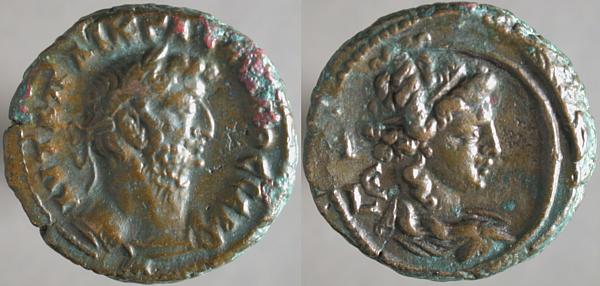
ΑΥΤ Κ Π ΛΙΚ ΓΑΛΛΙΗΝΟC CΕΒ, Laureate cuirassed bust right | LIΕ, Diademed draped bust of Selene right, regnal year left.
Minted in the last year of Gallienus's reign (and of his life), this coin of Roman Egypt shows a bust of Selene, the Greek moon goddess, who was adopted by the Romans as Luna. Yesterday's imperial coin showed Luna wearing crescent head-gear and carrying a long torch, but I find I have no provincials of this reign showing Selene as anything but a head.
Monday, July 12, 2004
Silvered Æ antoninianus, Gallienus, Antioch, Göbl 1664g
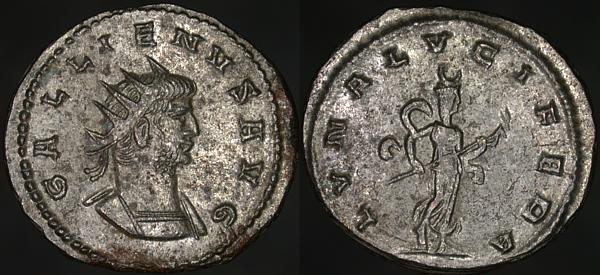
GALLIENVS AVG, Radiate cuirassed bust right | LVNA LVCIFERA, Luna standing right, crescent on head, carrying long torch.
Luna, the moon, equivalent to the Greek Selene, doesn't make many personal appearances on imperial coins, though the crescent beneath portraits of empresses is her sign as clearly as the radiate crown that emperors wear is symbolic of Sol.
Sunday, July 11, 2004
Æ20, Anemourion in Cilicia, Gallienus, Lindgren III 800var
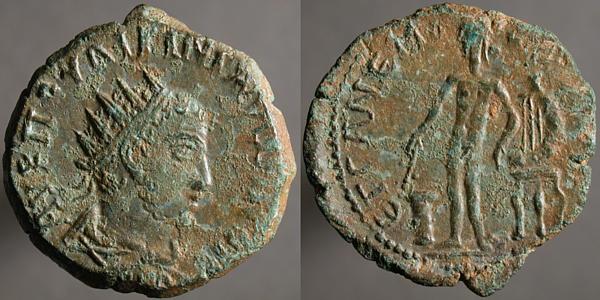
ΑV ΠΟΥ ΛΙΚΙΝ ΓΑΛΛΙΗ[ΝΟΝ], Radiate draped cuirassed bust right | ΕΤ Γ ΑΝΕΜ[Ο ΥΡΙΕωΝ], Apollo standing facing, head right, holding wand over cippus left. Lyre on table right.
My coins of this city for Valerian, dated ΕΤ Β (254-255), are 27mm, a bit larger than a US quarter. This, for Gallienus, dated a year later, is 20mm, just smaller than a nickel, on a tapered flan like that of mid-2nd Century Alexandrian coins. Lindgren catalogs it for the previous year, I've not seen it listed for this year (ΕΤ Γ.)
Interesting that the lyre here is in harp-like, with a frame with a large opening to the side, where most I've seen on coins were shaped more like a lucky horse-shoe, with a smaller open area to the top. Still, it's clearly Apollo, so we must call it a lyre.

